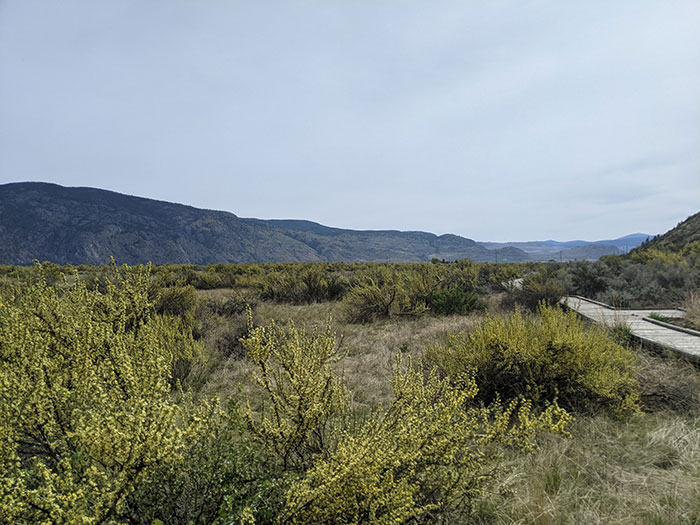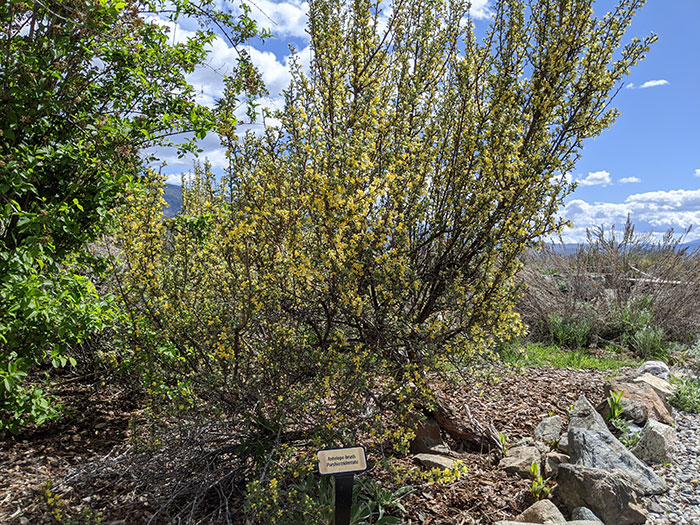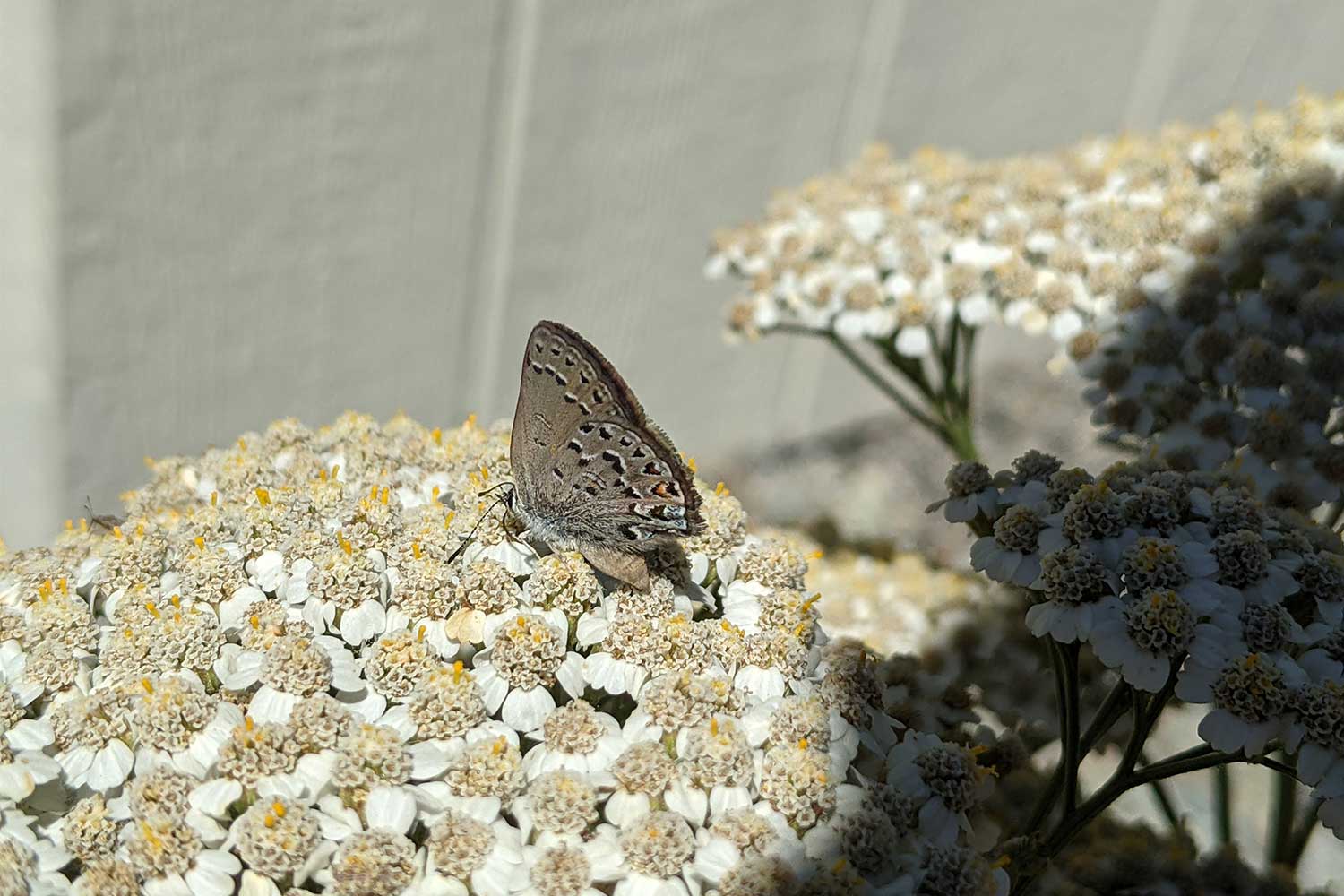Can We End this Endangered Butterfly’s Losing Streak?
The Behr’s hairstreak could go extinct in Canada if we don’t protect the rare desert ecosystem it depends on.
A Behr’s hairstreak seems like a drab fuzzy insect with dusty grey wings. But, as it opens them, it reveals a vivid smear of orange-black.
Every June, the Behr’s hairstreak butterfly takes flight over the Okanagan Desert in southern BC. The butterfly, like the desert, is a lesson in hidden beauty. With its wings folded, it appears drab: a fuzzy insect with alien-huge eyes and dusty grey wings. But, as it opens its wings, it reveals a vivid smear of orange-black.
The Behr’s hairstreak is dependent on antelope brush — a tall shrub with waxy three-pronged leaves and yellow five-petaled flowers. Antelope brush grows from San Diego, CA, to around Okanagan Falls, BC, and lends its name to the antelope-brush shrub-steppe ecosystem, the scientific descriptor for the narrow sliver of desert stretching approximately 55 km from Skaha Lake to Osoyoos.
Our best guess is that in the next three years, we won’t see any Behr’s hairstreaks.
Whether a larva hatching, chrysalis stewing or mature butterfly taking its first flight, the Behr’s hairstreak does it all from the stalks of antelope brush. Even as adults, they return to the plant for shelter and rest during bad weather and long days. Because the hairstreak’s life cycle is so tied to antelope brush, the health of the hairstreak population can serve as a window into the health of the whole ecosystem.
Unfortunately, if observations made at the Osoyoos Desert Centre (ODC) are any indication, the Behr’s hairstreak seems to be on a long march to extirpation — sometimes called “local extinction” — in the Okanagan Desert. Leor Oren, the centre’s manager, is not optimistic. “Our best guess is that in the next three years, we won’t see any Behr’s hairstreaks,” he says.

The ODC was established as an education centre and nature preserve in 1997, when the Osoyoos Desert Society acquired just over 27 hectares of land through a government lease. The society restored the land — formerly used for cattle grazing — to its natural state. Visitors to the ODC learn about the shrub-steppe ecosystem through a boardwalk trail, a native plant garden, and educational events. Meanwhile, volunteers and researchers conduct conservation activities like digging ponds for spadefoot toads, restoration work like culling invasive plants, and local species monitoring, including tracking populations like the hairstreak’s.
When UBC ecology student Andres Mancera Barreto worked as a conservation guide at the ODC in the summer of 2021, he conducted a two-week search for the hairstreak. He only found three butterflies in that entire time, a massive drop from earlier observations in 2003, when a mean of 12 individuals were spotted per day.
In the summer of 2021, Mancera Barreto conducted a two-week search for the hairstreak. He only found three butterflies in that entire time.
The ODC’s land should, hypothetically, be perfect for the Behr’s hairstreak: it is filled with antelope brush to feed larvae and shelter adult butterflies, and abounds with plants the species feeds on, like yarrow. And it has a dedicated team of conservationists who cull invasive plants that could outcompete the butterfly’s native food sources.
“In hypothesis, it is perfect,” Mancera Barreto says. “In practice, it is a bit more complicated.” He explains that there are many possible reasons for this decline, but the most likely factor is the continued fracturing of the antelope-brush shrub-steppe.
ODC manager Oren explains that in BC, “arid environments are currently not as protected as other environments. And the proximity of these arid environments to fantastic crop-growing habitats puts a lot of pressure on this ecosystem.” In the past few decades, intensifying land uses like wineries, ranching, and settlements have cut the ecosystem into smaller and smaller islands. In the case of the Behr’s hairstreak, “It’s a small butterfly that struggles to travel from patch to patch,” says Oren. Often, these patches cannot support viable populations of butterflies in isolation, and the environments around the islands can block butterflies (and other species) from circulating from island to island to restore depleted numbers. Slowly, species are choked out.

In the case of the ODC, Mancera Barreto suspects that its isolation from other antelope brush patches — combined with the presence of highways, farms, settlement, and other human activity — is probably the main cause for the butterfly’s decline in that area.
Reversing the decline of the Behr’s hairstreak — and of the antelope brush shrub-steppe as a whole — would be a tall order. Organizations like the ODC conserve and restore the areas they can, but real solutions would require local, national, and scientific investment into the ecosystem.
On the local side, Mancera Barreto posits that a series of corridors filled with antelope brush and other native plants running from the ODC to other patches of shrub-steppe, could buoy the Behr’s hairstreak’s sinking population. He notes that, in theory, corridors could increase food sources, maneuverability, and genetic diversity for multiple species, including the butterfly.
Reversing the decline of the Behr’s hairstreak — and of the antelope brush shrub-steppe as a whole — would be a tall order.
On the national side, Canadians in general would need to grow their awareness and appreciation for the antelope-brush shrub-steppe. The desert itself is plenty charismatic: “People that come to visit, and learn about our desert environment, walk away absolutely amazed,” says Jayme Friedt, managing director at the ODC. However, the desert does not have the same publicity as Vancouver Island’s ancient rainforests or Ontario’s wetlands. Closing that cultural gap could help spur action on desert preservation.
The largest issue is the scientific side. While other biomes in Canada are well-researched, the Okanagan Desert’s small size has left it comparatively overlooked. Mancera Barreto points out that many specialities are needed to study ecosystems, and smaller ecosystems have trouble attracting the critical mass of researchers needed to grow scientific understanding.
Despite these difficulties, organizations like the ODC persist. The centre is currently participating in a large-scale effort to establish how much antelope-brush shrub-steppe actually remains within the south Okanagan after the latest round of land-use changes and wildfires. This has already identified where gaps exist and what partners are needed to establish greater connectivity in the region. And, though there aren’t clear guidelines for regrowing antelope brush in areas where it has been cleared, researchers at the ODC and beyond are currently looking into developing best practices, which could be vital for future restoration work.

Preserving the Behr’s hairstreak offers an incredible opportunity. Lifting up this butterfly would require restoring antelope brush, thereby supporting all the species that also depend on the shrub to thrive. This lift is urgently needed: statistics vary, but the South Okanagan Conservation Fund estimates that up to 68% of antelope-brush shrub-steppe has already been destroyed, and only 13% is formally protected.
A national park might change these numbers; a proposed park between the Similkameen and Okanagan rivers is currently outlined within a memorandum of understanding signed between the Canadian federal government, the government of BC, and the Syilx/Okanagan Nation. However, many negotiations and discussions lie between this agreement and an official park.
This is a complex list of efforts to confront a vast and thorny problem. But together, they could offer a tantalizingly simple reward: a future June aflutter with orange-black wings.
Print Issue: Summer/Fall 2022
Print Title: Can We End this Butterfly's Losing Streak?
